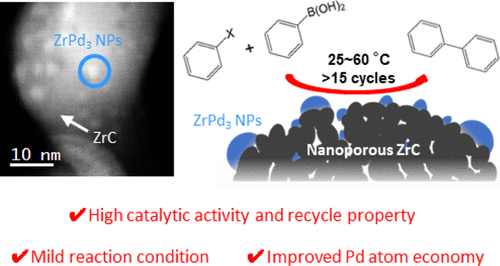当前位置:
X-MOL 学术
›
ACS Catal.
›
论文详情
Our official English website, www.x-mol.net, welcomes your
feedback! (Note: you will need to create a separate account there.)
Intermetallic ZrPd3-Embedded Nanoporous ZrC as an Efficient and Stable Catalyst of the Suzuki Cross-Coupling Reaction
ACS Catalysis ( IF 11.3 ) Pub Date : 2020-11-24 , DOI: 10.1021/acscatal.0c03416 Yangfan Lu 1 , Tian-Nan Ye 1 , Sang-Won Park 1, 2 , Jiang Li 1 , Masato Sasase 1 , Hitoshi Abe 3, 4, 5 , Yasuhiro Niwa 3, 4 , Masaaki Kitano 1 , Hideo Hosono 1, 2
ACS Catalysis ( IF 11.3 ) Pub Date : 2020-11-24 , DOI: 10.1021/acscatal.0c03416 Yangfan Lu 1 , Tian-Nan Ye 1 , Sang-Won Park 1, 2 , Jiang Li 1 , Masato Sasase 1 , Hitoshi Abe 3, 4, 5 , Yasuhiro Niwa 3, 4 , Masaaki Kitano 1 , Hideo Hosono 1, 2
Affiliation

|
The Suzuki cross-coupling reaction, which is generally catalyzed by Pd-based materials, is a practical approach to create C–C bonds. Although heterogeneous catalysts, including metal-loaded and intermetallic catalysts, afford simple reaction conditions and catalyst reusability, it is challenging to achieve high catalytic activity, durability, and Pd-atom economy together in a single catalyst. Herein, we report the successful preparation of Pd–ZrC, a Pd-based catalyst with the described desirable features. In it, a-few-nanometer-sized nanoparticles of intermetallic ZrPd3 are uniformly dispersed on the surface of nanoporous ZrC with a surface area of 340–450 m2 g–1. As a result of the presence of electron-rich Pd sites and the material’s strong electron-donating ability, Pd–ZrC achieved high catalytic performance in Suzuki cross-coupling reactions at room temperature. Because a low Pd content (1 wt %) is sufficient to produce highly catalytically active Pd–ZrC, this material represents a great improvement in terms of Pd-atom economy over previously reported catalysts. Moreover, no catalytic degradation was noted over up to the presented 15 reaction cycles as the active Pd sites were stabilized in the ZrPd3 lattice. These results indicate that Pd–ZrC has the advantages of both metal-loaded and intermetallic catalysts, providing an approach to enhance the degree of freedom for designing heterogeneous catalysts.
中文翻译:

金属间化合物ZrPd 3嵌入纳米孔ZrC作为Suzuki交叉偶联反应的高效稳定催化剂
通常由基于Pd的材料催化的Suzuki交叉偶联反应是创建CC键的实用方法。尽管包括金属负载的催化剂和金属间的催化剂在内的多相催化剂提供简单的反应条件和催化剂的可重复使用性,但是在单个催化剂中一起实现高催化活性,耐久性和Pd-原子经济性是具有挑战性的。在这里,我们报告成功地制备了Pd-ZrC,这是一种具有上述理想功能的基于Pd的催化剂。其中,几纳米大小的金属间化合物ZrPd 3纳米颗粒均匀地分散在纳米多孔ZrC的表面上,表面积为340–450 m 2 g –1。由于存在富电子的Pd位和该材料强大的供电子能力,Pd-ZrC在室温下的Suzuki交叉偶联反应中获得了很高的催化性能。由于低的Pd含量(1 wt%)足以产生高催化活性的Pd-ZrC,因此与以前报道的催化剂相比,该材料在Pd原子经济性方面代表了巨大的进步。此外,由于活性Pd位点稳定在ZrPd 3晶格中,因此在目前的15个反应周期内都未发现催化降解。这些结果表明,Pd-ZrC既具有载金属催化剂又具有金属间催化剂的优势,为提高设计多相催化剂的自由度提供了一种方法。
更新日期:2020-12-18
中文翻译:

金属间化合物ZrPd 3嵌入纳米孔ZrC作为Suzuki交叉偶联反应的高效稳定催化剂
通常由基于Pd的材料催化的Suzuki交叉偶联反应是创建CC键的实用方法。尽管包括金属负载的催化剂和金属间的催化剂在内的多相催化剂提供简单的反应条件和催化剂的可重复使用性,但是在单个催化剂中一起实现高催化活性,耐久性和Pd-原子经济性是具有挑战性的。在这里,我们报告成功地制备了Pd-ZrC,这是一种具有上述理想功能的基于Pd的催化剂。其中,几纳米大小的金属间化合物ZrPd 3纳米颗粒均匀地分散在纳米多孔ZrC的表面上,表面积为340–450 m 2 g –1。由于存在富电子的Pd位和该材料强大的供电子能力,Pd-ZrC在室温下的Suzuki交叉偶联反应中获得了很高的催化性能。由于低的Pd含量(1 wt%)足以产生高催化活性的Pd-ZrC,因此与以前报道的催化剂相比,该材料在Pd原子经济性方面代表了巨大的进步。此外,由于活性Pd位点稳定在ZrPd 3晶格中,因此在目前的15个反应周期内都未发现催化降解。这些结果表明,Pd-ZrC既具有载金属催化剂又具有金属间催化剂的优势,为提高设计多相催化剂的自由度提供了一种方法。











































 京公网安备 11010802027423号
京公网安备 11010802027423号